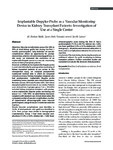Implantable Doppler Probe as a Vascular Monitoring Device in Kidney Transplant Patients: Investigation of Use at a Single Center
| dc.contributor.author | Malik, MS | |
| dc.contributor.author | Akoh, J | |
| dc.contributor.author | Aroori, S | |
| dc.contributor.author | Latour, JM | |
| dc.date.accessioned | 2022-05-03T12:26:48Z | |
| dc.date.available | 2022-05-03T12:26:48Z | |
| dc.date.issued | 2022-04 | |
| dc.identifier.issn | 1304-0855 | |
| dc.identifier.issn | 2146-8427 | |
| dc.identifier.uri | http://hdl.handle.net/10026.1/19147 | |
| dc.description.abstract |
OBJECTIVES: Vascular complications account for 30% to 35% of total kidney grafts lost during the first 3 months posttransplant. Early detection of vascular complications allows an opportunity for prompt intervention, which is critical to reducing graft loss. In this study, we evaluated the usefulness of an implantable Doppler probe as a vascular monitoring device in kidney transplant patients. MATERIALS AND METHODS: An implantable Doppler probe is used intermittently for postoperative monitoring of kidney transplant patients at our center. In this retrospective study, we analyzed prospectively maintained medical data in which we compared clinical outcomes of kidney transplant recipients who had postoperative implantable Doppler probe monitoring versus standard care clinical observation. Between January 2016 and October 2021, 324 kidney transplant patients were seen at our center. Patients were divided into 2 groups: group 1 (n = 194; 60%) included kidney transplant recipients with postoperative implantable Doppler probe monitoring and group 2 (n = 129; 40%) included kidney transplant recipients with standard care clinical observation. We compared number of vascular complications, number of departmental ultrasonographic scans required posttransplant, and graftloss at 3 months between the 2 groups. RESULTS: Vascular complications were identified in 13.5% of total patients, with graft loss identified in 2.1%. Both groups were similar in demographical characteristics. Group 1 had more vascular complications (17.5% vs 9.3%; relative risk = 1.88), fewer ultrasonographic scans during the first 24 hours posttransplant (71.1% vs 83.7%; relative risk = 0.84), and lower graft loss (1.5% vs 3.1%; relative risk = 0.48) than group 2. All probes were removed safely after 72 hours, and no complications related to the device were reported. CONCLUSIONS: The monitoring device may be used as an additional adjunct for graft monitoring in kidney transplant patients. Further controlled studies are warranted to evaluate this device in clinical practice. | |
| dc.format.extent | 355-361 | |
| dc.format.medium | ||
| dc.language | eng | |
| dc.language.iso | eng | |
| dc.publisher | Baskent University | |
| dc.subject | Blood flow | |
| dc.subject | Graft perfusion surveillance | |
| dc.subject | Renal transplantation | |
| dc.title | Implantable Doppler Probe as a Vascular Monitoring Device in Kidney Transplant Patients: Investigation of Use at a Single Center | |
| dc.type | journal-article | |
| dc.type | Article | |
| plymouth.author-url | https://www.ncbi.nlm.nih.gov/pubmed/35475419 | |
| plymouth.issue | 4 | |
| plymouth.volume | 20 | |
| plymouth.publication-status | Published | |
| plymouth.journal | Experimental and Clinical Transplantation | |
| dc.identifier.doi | 10.6002/ect.2021.0500 | |
| plymouth.organisational-group | /Plymouth | |
| plymouth.organisational-group | /Plymouth/Faculty of Health | |
| plymouth.organisational-group | /Plymouth/Faculty of Health/School of Nursing and Midwifery | |
| plymouth.organisational-group | /Plymouth/REF 2021 Researchers by UoA | |
| plymouth.organisational-group | /Plymouth/REF 2021 Researchers by UoA/UoA03 Allied Health Professions, Dentistry, Nursing and Pharmacy | |
| plymouth.organisational-group | /Plymouth/Research Groups | |
| plymouth.organisational-group | /Plymouth/Research Groups/Institute of Health and Community | |
| plymouth.organisational-group | /Plymouth/Research Groups/Plymouth Institute of Health and Care Research (PIHR) | |
| plymouth.organisational-group | /Plymouth/Users by role | |
| plymouth.organisational-group | /Plymouth/Users by role/Academics | |
| dc.publisher.place | Turkey | |
| dcterms.dateAccepted | 2022-02-01 | |
| dc.rights.embargodate | 2022-7-9 | |
| dc.identifier.eissn | 2146-8427 | |
| dc.rights.embargoperiod | Not known | |
| rioxxterms.versionofrecord | 10.6002/ect.2021.0500 | |
| rioxxterms.licenseref.uri | http://www.rioxx.net/licenses/all-rights-reserved | |
| rioxxterms.type | Journal Article/Review |


